Lamassu
Lama, Lamma or Lamassu (Cuneiform: 𒀭𒆗, an.kal; Sumerian: dlammař; later in Akkadian: lamassu; sometimes called a lamassus[1][2]) is a Sumerian protective deity.[3] Initially depicted as a female deity in Sumerian times, when it was called Lamma, it was later depicted from Assyrian times as a hybrid of a human, bird, and either a bull or lion—specifically having a human head, the body of a bull or a lion, and bird wings, under the name Lamassu.[3][4] In some writings, it is portrayed to represent a female deity.[5] A less frequently used name is shedu (Cuneiform: 𒀭𒆘, an.kal×bad; Sumerian: dalad; Akkadian, šēdu), which refers to the male counterpart of a lamassu.[6] Lammasu represent the zodiacs, parent-stars or constellations.[7][8]
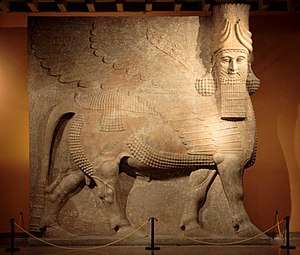
Female goddess Lama
The goddess Lama appears initially as a mediating goddess who precedes the orants and presents them to the gods.[3] The protective deity is clearly labelled as Lam(m)a in a Kassite stele unearthed at Uruk, in the temple of Ishtar, goddess to which she had been dedicated by king Nazi-Maruttash (1307-1282 BCE).[9] It is a goddess wearing a ruffled dress and wearing a horned tiara symbolizing the deity, with two hands raised, in sign of prayer. A. Spycket proposed that similar female figures appearing in particular in glyptics and statuary from the Akkadian period, and in particular in the presentation scenes (common especially in the Paleo-Babylonian era) were to be considered as Lam(m)a.[10] This opinion is commonly followed and in artistic terminology these female figures are generally referred to as Lam(m)a.[3] From Assyrian times, Lamma becomes a hybrid deity, half-animal, half-human.[3]
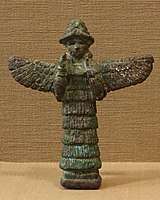 Lamma as protective winged deity. Isin-Larsa period (2000-1800 BCE).
Lamma as protective winged deity. Isin-Larsa period (2000-1800 BCE).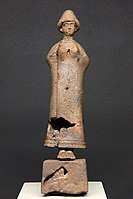 Statuette of the goddess Lama, probably from the city of Mari. Isin-Larsa period (2000-1800 BCE).
Statuette of the goddess Lama, probably from the city of Mari. Isin-Larsa period (2000-1800 BCE).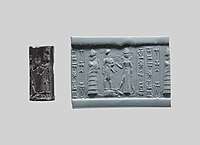 Cylinder seal showing the representation of a devotee (center) by goddedd Lamma (left), to Ishtar (right). Babylonian, ca. 18th–17th century BCE Metropolitan Museum of Art.
Cylinder seal showing the representation of a devotee (center) by goddedd Lamma (left), to Ishtar (right). Babylonian, ca. 18th–17th century BCE Metropolitan Museum of Art.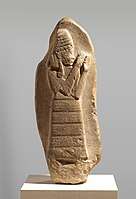 Stele with inscription showing the protectrice deity Lam(m)a, dedicated by king Nazi-Maruttash to goddess Ishtar, from Uruk (1307-1282 BCE). Metropolitan Museum of Art.
Stele with inscription showing the protectrice deity Lam(m)a, dedicated by king Nazi-Maruttash to goddess Ishtar, from Uruk (1307-1282 BCE). Metropolitan Museum of Art.
Lamassu iconography
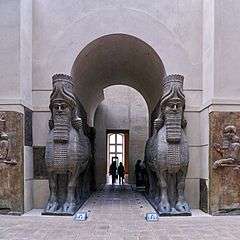
From Assyrian times, lamassu were depicted as hybrids, with bodies of either winged bulls or lions and heads of human males.[3] The motif of a winged animal with a human head is common to the Near East, first recorded in Ebla around 3000 BCE. The first distinct lamassu motif appeared in Assyria during the reign of Tiglath-Pileser II as a symbol of power.[11][12]
Assyrian sculpture typically placed prominent pairs of lamassu at entrances in palaces, facing the street and also internal courtyards. They were represented as "double-aspect" figures on corners, in high relief. From the front they appear to stand, and from the side, walk, and in earlier versions have five legs, as is apparent when viewed obliquely. Lumasi do not generally appear as large figures in the low-relief schemes running round palace rooms, where winged genie figures are common, but they sometimes appear within narrative reliefs, apparently protecting the Assyrians.[13]
The colossal entranceway figures were often followed by a hero grasping a wriggling lion, also colossal in scale and in high relief. In the palace of Sargon II at Dur-Sharrukin, a group of at least seven lamassu and two such heroes with lions surrounded the entrance to the "throne room", "a concentration of figures which produced an overwhelming impression of power."[14] They also appear on cylinder seals. Notable examples include those at the Gate of All Nations at Persepolis in Iran, the British Museum in London, the Louvre in Paris, the National Museum of Iraq in Baghdad, the Metropolitan Museum of Art in New York and the University of Chicago Oriental Institute. Several examples left in situ in northern Iraq were destroyed in the 2010s by the Islamic State of Iraq and the Levant when they occupied the area, as were those in the Mosul Museum.
Terminology
Lamassu represent the zodiacs, parent-stars, or constellations.[7][8] They are depicted as protective deities because they encompass all life within them. In the Sumerian Epic of Gilgamesh, they are depicted as physical deities as well, which is where the lammasu iconography originates, these deities could be microcosms of their microcosmic zodiac, parent-star, or constellation. Although lamassu had a different iconography and portrayal in the culture of Sumer, the terms "lamassu", "alad", and "shedu" evolved throughout the Assyro-Akkadian culture from the Sumerian culture to denote the Assyrian-winged-man-bull symbol and statues during the Neo-Assyrian Empire. Female lamassu were called "apsasû".[4]
_from_Nimrud_2.jpg)
The motif of the Assyrian-winged-man-bull called Aladlammu and Lamassu interchangeably is not the lamassu or alad of Sumerian origin, which were depicted with different iconography. These monumental statues were called aladlammû or lamassu which meant "protective spirit".[4] In Hittite, the Sumerian form dlamma is used both as a name for the so-called "tutelary deity", identified in certain later texts with Inara, and a title given to similar protective gods.[15]
Mythology
The lamassu is a celestial being from ancient Mesopotamian religion bearing a human head, bull's body, sometimes with the horns and the ears of a bull, and wings. It appears frequently in Mesopotamian art. The lamassu and shedu were household protective spirits of the common Babylonian people, becoming associated later as royal protectors, and were placed as sentinels at entrances.[16] The Akkadians associated the god Papsukkal with a lamassu and the god Išum with shedu.
To protect houses, the lamassu were engraved in clay tablets, which were then buried under the door's threshold. They were often placed as a pair at the entrance of palaces. At the entrance of cities, they were sculpted in colossal size, and placed as a pair, one at each side of the door of the city, that generally had doors in the surrounding wall, each one looking towards one of the cardinal points.
The ancient Jewish people were influenced by the iconography of Assyrian culture. The prophet Ezekiel wrote about a fantastic being made up of aspects of a human being, a lion, an eagle and a bull.[17] Later, in the early Christian period, the four Gospels were ascribed to each of these components. When it was depicted in art, this image was called the Tetramorph.
In modern culture
The British 10th Army, which operated in Iraq and Iran in 1942–1943, adopted the lamassu as its insignia. A bearded man with a winged bull body appears on the logo of the United States Forces – Iraq.
A man with a bull's body is found among the creatures that make up Aslan's army in The Lion, the Witch and the Wardrobe by C. S. Lewis. He appears at the Stone Table, challenging the White Witch "with a great bellowing voice". In the film Alexander (2004), lamassu are seen at the Ishtar Gate in Babylon. In the Disney movie Aladdin (1992), a gold lamassu can be found in the scene where Aladdin and Abu enter the cave in the desert to find the lamp.
Michael Rakowitz, a Northwestern University professor of Art Theory & Practice won a Fourth Plinth commission to recreate the Lamassu that stood in Nineveh, Iraq, from 700 BC until it was destroyed by ISIS in 2015. Rakowitz's sculpture will be displayed in London's Trafalgar Square beginning in 2018.[18]
2 lamassus can be seen on night at the museum 3 in the background with other animals such turtles on a scene when the main characters march to the egyptian section of the british museum
Games
Lammasu [sic] and shedu are two distinct types of good-aligned creatures in the role-playing game Dungeons & Dragons—with Lammasu having the bodies of winged lions and shedu depicted as human-headed winged bulls.
Lammasu appear in the Magic: The Gathering trading card game as the white card Hunted Lammasu[19] in the Ravnica expansion, as well as the white card Venerable Lammasu[20] found in the Khans of Tarkir expansion.
In the Games Workshop miniatures wargame, Warhammer Fantasy Battle, the Lamasu was a mount for the Chaos Dwarf army. It has since returned as part of the Storm of Magic expansion release. A Lammasu briefly appears in the Fablehaven series.
In the video-game Might And Magic Heroes VI the lamassu (though with only one S) is a recruitable elite creature of the necropolis faction (undead).
Gallery
_~_Assyrian_Empire_%2B_Lamassu%2C_Gates_at_Balawat%2C_Relief_Panel's_%26_Full_Projection.3.jpg)
- The British Museum - Human Headed Winged Bulls from Dur-Sharrukin
- The British Museum - Human Headed Winged Lion and Bull from Nimrud, companion pieces in Metropolitan Museum of Art
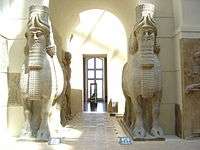 Louvre - Human Headed Winged Bulls from Dur-Sharrukin
Louvre - Human Headed Winged Bulls from Dur-Sharrukin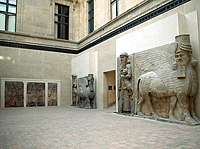 Louvre - Human Headed Winged Bulls, Sculpture and Reliefs from Dur-Sharrukin; note the lamassu in the foreground is a cast from the University of Chicago Oriental Institute
Louvre - Human Headed Winged Bulls, Sculpture and Reliefs from Dur-Sharrukin; note the lamassu in the foreground is a cast from the University of Chicago Oriental Institute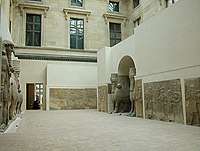 Louvre - Human Headed Winged Bulls and Reliefs from Dur-Sharrukin, in their wider setting of reliefs
Louvre - Human Headed Winged Bulls and Reliefs from Dur-Sharrukin, in their wider setting of reliefs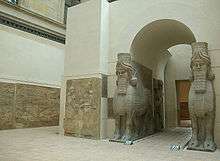 Louvre - Human Headed Winged Bulls and Reliefs from Dur-Sharrukin
Louvre - Human Headed Winged Bulls and Reliefs from Dur-Sharrukin_MET_DP252320.jpeg) The Metropolitan Museum of Art - Human Headed Winged Lion and Bull from Nimrud, companion pieces to those in the British Museum
The Metropolitan Museum of Art - Human Headed Winged Lion and Bull from Nimrud, companion pieces to those in the British Museum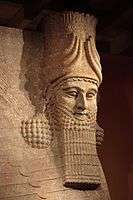 Detail, University of Chicago Oriental Institute. Gypsum(?), Dur-Sharrukin, entrance to the throne room, c. 721-705 B.C
Detail, University of Chicago Oriental Institute. Gypsum(?), Dur-Sharrukin, entrance to the throne room, c. 721-705 B.C Cuneiform script on the back of a lamassu in the University of Chicago Oriental Institute.
Cuneiform script on the back of a lamassu in the University of Chicago Oriental Institute.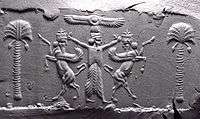 Modern impression of Achaemenid cylinder seal, fifth century BCE. A winged solar disc legitimises the Achaemenid emperor, who subdues two rampant Mesopotamian lamassu figures
Modern impression of Achaemenid cylinder seal, fifth century BCE. A winged solar disc legitimises the Achaemenid emperor, who subdues two rampant Mesopotamian lamassu figures- Insignia of the British 10th Army
 Insignia of the SAVAK of Iran
Insignia of the SAVAK of Iran The entrance of a fire temple in Fort Mumbai displaying a lamassu
The entrance of a fire temple in Fort Mumbai displaying a lamassu Seal of United States Forces – Iraq
Seal of United States Forces – Iraq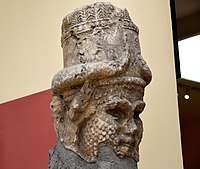 Head of lamassu. Marble, 8th century BCE, from Assur, Iraq. Ancient Orient Museum, Istanbul
Head of lamassu. Marble, 8th century BCE, from Assur, Iraq. Ancient Orient Museum, Istanbul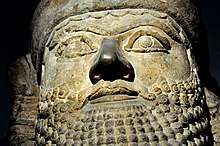 Head of a lamassu from the palace of Esarhaddon, from Nimrud, Iraq, 7th century BC. The British Museum
Head of a lamassu from the palace of Esarhaddon, from Nimrud, Iraq, 7th century BC. The British Museum_of_the_North-West_Palace_at_Nimrud%2C_Iraq%2C_9th_century_BC._The_British_Museum%2C_London.jpg) Lamassu from the Throne Room (Room B) of the North-West Palace at Nimrud, Iraq, 9th century BC. The British Museum, London
Lamassu from the Throne Room (Room B) of the North-West Palace at Nimrud, Iraq, 9th century BC. The British Museum, London
See also
| Wikimedia Commons has media related to Shedu. |
- Anzû (older reading: Zû), Mesopotamian monster
- Apis
- Buraq
- Centaur
- Cherub
- Chimera, Greek mythological hybrid monster
- Enlil
- Fire Temples
- Griffin or griffon, lion-bird hybrid
- Harpy
- Jinn
- Kamadhenu, Hindu bovine goddess
- Lakhmu, Akkadian deity also known as Lammasu
- Manticore, Persian sphinx-like creature
- Mermaid
- Minotaur
- Mythological hybrid
- List of hybrid creatures in mythology
- Pamola, the Abenaki-origin indigenous American "winged-moose" spirit protecting Mount Katahdin
- Pegasus, winged stallion in Greek mythology
- Sharabha, Hindu mythology: lion-bird hybrid
- Simurgh, Iranian mythical flying creature
- Sphinx, mythical creature with lion's body and human head
- Thunderbird (mythology)
- Yali, Hindu mythological lion-elephant-horse hybrid
- Ziz, giant griffin-like bird in Jewish mythology
Notes
- Kriwaczek, Paul. Babylon: Mesopotamia and the Birth of Civilization, p. 37.
- http://www.torrossa.it/resources/an/2401509#page=241
- Leick, Dr Gwendolyn (2002). A Dictionary of Ancient Near Eastern Mythology. Routledge. pp. 109–110. ISBN 978-1-134-64102-4.
- Livius.org
- Beaulieu, Paul-Alain (2003). The Pantheon of Uruk During the Neo-Babylonian Period. Brill. ISBN 90-04-13024-1.CS1 maint: ref=harv (link)
- Black, Jeremy; Green, Anthony (2003). An Illustrated dictionary, Gods, Demons and Symbols of Ancient Mesopotamia. The British Museum Press. ISBN 0-7141-1705-6.
- Hewitt, J.F. History and Chronology of the Myth-Making Age. p. 85.
- W. King, Leonard. Enuma Elish Vol 1 & 2: The Seven Tablets of Creation; The Babylonian and Assyrian Legends Concerning the Creation of the World and of Mankind. p. 78.
- "The deity which we have here called the Babylonian Goddess has been identified as the goddess Lama thanks to an inscription found at Uruk. Agnes Spycket has discussed the textual references to this interceding deity, and the way she is represented in art." Collon, Dominique (1975). The seal impressions from Tell Atchana/Alalakh. Butzon & Bercker. p. 181. ISBN 978-3-7887-0469-8.
- Spycket, Agnès (1960). "La Déesse Lama". Revue d'Assyriologie et d'archéologie orientale. 54 (2): 73–84. ISSN 0373-6032. JSTOR 23294909.
- "History – Mesopotamia". BBC.
- "Lamassu". ancientneaeast.net.
- Frankfort, 147–148
- Frankfort, 147–148, 148 quoted
- McMahon, John Gregory (1991). The Hittite State Cult of the Tutelary Deities. Oriental Institute of the University of Chicago. ISBN 978-0-918986-69-6.CS1 maint: ref=harv (link)
- Castor, Marie-José. "Winged human-headed bull". Louvre.fr. Retrieved February 19, 2017.
- Bodi, Daniel. "The Book of Ezekiel and the Poem of Erra" (PDF).
- "The Lamassu, Resurrected".
- "Hunted Lammasu".
- "Venerable Lammasu".
- "Assyrian Human Headed Winged Lion and Bull (Lamassu)". Smarthistory at Khan Academy. Retrieved January 8, 2013.
References
- Frankfort, Henri, The Art and Architecture of the Ancient Orient, Pelican History of Art, 4th ed 1970, Penguin (now Yale History of Art), ISBN 0140561072
External links
- Webpage about the Šêdu in the Louvre Museum (in French)